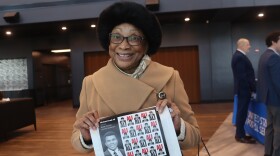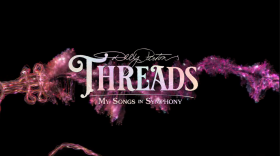Miki’s vibrant felt sculptures in the exhibition “Shapeshifting” are warm and welcoming. They invite the viewer to dive deep into how mythmaking has twisted the world’s narratives, shaping human behavior and impacting history.
The pieces in “Shapeshifting”— which is currently showing at KMAC Contemporary Art Museum — almost look like pop-art furniture, and wouldn’t be out of place in a mid-century modern home. The surreal sculptures blend the contours of people, plants and animals with the aesthetics of inanimate objects using bright color schemes and playful elements like polka dots. The intricate meaning behind the exhibition will leave you thinking about the things that society believes — possibly the things that you believe — for days.
For each sculpture, Miki invents a character based on the motifs of “Night Parade of One Hundred Demons,” a prominent piece of Japanese folklore in which supernatural creatures march through the streets. The stories surrounding “Night Parade” have been told and interpreted in many ways for hundreds of years, but Miki’s characters, which she calls “incomplete deities,” represent those who have been marginalized.
The exhibition also examines mythmaking’s impact at large. While the idea of mythology might bring to mind ancient heroes, spiritual parables or children’s stories, it’s also deeply intertwined with devastating aspects of society like violence, racism, sexism, homophobia and xenophobia.
Fundamentally, Miki uses her work to ask the question: If traditional myths are harmful, why don’t we update them, or create new ones?
“It’s kind of fascinating how these fictions can drive entire countries, nations and the world,” Miki told LPM News. “If you manipulate and communicate them well enough, people believe them, and this is a big part of us, bringing us together, but in a really negative cause. We have too many of these manipulative myths that we need to get rid of, I think. We really need to update them.”
“Shapeshifting,” which will be at KMAC until Sunday, Aug. 6, also has a sibling exhibition called “Spirits In The Material World,” which features pieces from the museum’s collection that correlate with Miki’s theme of spirits and celestial beings throughout mythology. “Spirits In The Material World” — which shares a floor with and closes the same day as “Shapeshifting” — covers several genres and time periods. It features art from Simone Leigh, Kathleen Lolley and others. There’s even an entire room dedicated to the devil.
KMAC Curatorial Director Joey Yates said that the museum is always trying to find interesting ways to show pieces in the collection.
“My curatorial assistant, Anna Blake, and I are always trying to find ways to utilize and present the collection, particularly in context with some of the guest artists we bring in,” Yates said.

‘A reflection of who we can become’
Miki was born in Japan, but the Bay Area of California has been her home for more than 20 years. She said that her bi-cultural identity is a driving force behind her art and that she wants her work to promote inclusivity.
“I hope these characters are a reflection of who we can become,” Miki said. “That we celebrate the diversity, we celebrate the idiosyncrasies. They’re very independent identities; they’re not conforming to a particular identity that has been accepted in folklore and mythologies.”
Some of the art in the exhibition was made years ago, but one piece, “Thoroughbred Ghost,” was created specifically for the show at the KMAC. It’s a brown and purple representation of a headless horse, inspired by the culture of Louisville and Kentucky. Miki said that she enjoyed spending time in Louisville this past spring and that people were kind and the hospitality was excellent, but when it comes to horse racing and the Kentucky Derby, she has “mixed feelings.”
“Thoroughbred Ghost,” like the rest of Miki’s work, is subtle on the surface, but a deeper and more thoughtful look can pull out some larger and more intense themes.
“There’s a little bit of tongue in cheek, I think,” she said.

Another piece, “Umbrella Ghost” — based on the mythical karakasa-obake ghosts in Japanese folklore — represents human-made tools that have been discarded. Miki said in Japan umbrellas are cheap, get thrown away easily and are treated like disposable objects. She said, metaphorically, that extends to how we sometimes treat each other. It’s also a rumination on waste and climate change.
And that’s the magic of Miki’s art: Like a myth, it can be interpreted in so many different ways. “Shapeshifting” is visceral, it’s magnetic.
The exhibition uses a series of broad ideas and endless thought experiments. What do the characters represent as individuals? What do they represent as a group? What are the larger themes of mythmaking? And Miki sees value in the ambiguity of that.
“I make these characters, but what do they project? I have intentions, and I have visual references and stories, but I wonder how they are going to be perceived,” Miki said. “And I think that’s an interesting part of it.”
Above all, Miki hopes society will embrace the idea that mythology has problems and needs to be reimagined.
“If we can’t imagine better, I don’t think we can move forward,” Miki said. “I think it’s too dire.”

The devil is in the details
The parallel exhibition, “Spirits In The Material World,” works in a similar way. Pieces by various artists are arranged to look at the impact of mythology and tradition on several eras, and how that extends to now.
In “Drawing Down the Moon,” Louisville-based artist Kathleen Lolley uses cut paper and found objects to explore the fantasy elements of ancient Celtic Samhain festivals that commemorate the end of the growing season. The scene depicts a high priestess performing a ritual that asks a goddess to speak through her.
There’s also a piece by Simone Leigh — who was named one of the 100 most influential people in the world by Time magazine in 2023 — called “Stack II,” in which she uses African pottery techniques to create art based on traditional forms of Nigerian water pots.
The room dedicated to the devil feels almost like an exhibition of its own. The various forms and interpretations are really powerful. One piece is a painted wood carving of what appears to be a human-made ship with devil figurines inside. Another is a wood carving of a horned devil with its mouth open. Inside its mouth is a mirror. As you examine the statue of the devil, you also see your own face.
A lasting theme isn’t just how the devil is intertwined with mythology, but within us, in our daily lives.
Yates said that provides a compelling juxtaposition to Miki’s work.
“[Miki] talks a lot about her shapeshifters, both her sculptures, but also within Shinto, that they can be evil and that they can be good,” Yates said. “And I think that’s something that is shared around the world in multiple belief systems, that spirits can be both evil and good, and the form that those take. In a lot of Western religions, the form that evil takes is the form of the demon, that we might think about. A horned beast that also looks like a human. That is a shapeshifter, in a different context.”
The collected works in “Spirits In The Material World” widen and strengthen the concepts of “Shapeshifting,” adding so many different perspectives on mythmaking throughout multiple centuries and places.
Combined, the two exhibitions are a powerful examination that will leave you reconsidering the long, intertwined relationship between fact and fiction.
The pieces never attempt full answers. Instead, the artwork strives to provide a lens for the viewer to think a little more carefully about the state of the world and how it became how it is — something that great art does.
KMAC Museum is among LPM's financial supporters.
Support for this story was provided in part by the Great Meadows Foundation.





